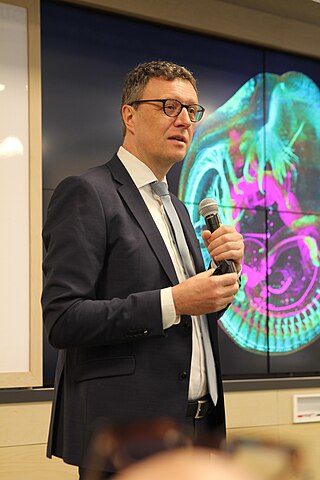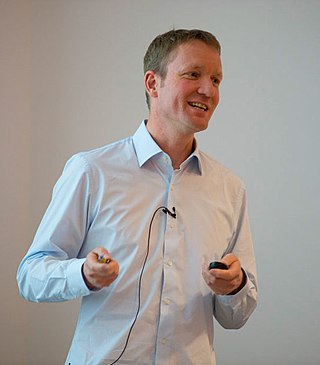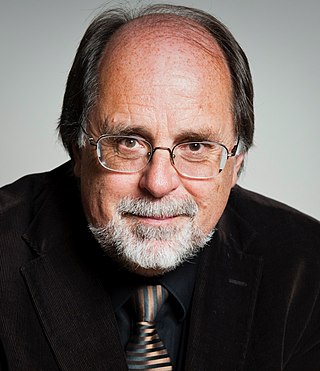Related Research Articles

Hartmut Michel is a German biochemist, who received the 1988 Nobel Prize in Chemistry for determination of the first crystal structure of an integral membrane protein, a membrane-bound complex of proteins and co-factors that is essential to photosynthesis.

The Max Planck Institute of Biochemistry is a research institute of the Max Planck Society located in Martinsried, a suburb of Munich. The institute was founded in 1973 by the merger of three formerly independent institutes: the Max Planck Institute of Biochemistry, the Max Planck Institute of Protein and Leather Research, and the Max Planck Institute of Cell Chemistry.

The Gottfried Wilhelm Leibniz Prize, or Leibniz Prize, is awarded by the German Research Foundation to "exceptional scientists and academics for their outstanding achievements in the field of research". Since 1986, up to ten prizes have been awarded annually to individuals or research groups working at a research institution in Germany or at a German research institution abroad. It is considered the most important research award in Germany.

Patrick Cramer is a German chemist, structural biologist, and molecular systems biologist. In 2020, he was honoured to be an international member of the National Academy of Sciences. He became president of the Max Planck Society in June 2023.

Matthias Mann is a German physicist and biochemist. He is doing research in the area of mass spectrometry and proteomics.
Franz-Ulrich Hartl is a German biochemist and the current Executive Director of the Max Planck Institute of Biochemistry. He is known for his pioneering work in chaperone-mediated protein folding.

Sir Christopher Martin Dobson was a British chemist, who was the John Humphrey Plummer Professor of Chemical and Structural Biology in the Department of Chemistry at the University of Cambridge, and Master of St John's College, Cambridge.
Wayne A. Hendrickson is an American biophysicist and university professor at Columbia. Dr. Hendrickson is a university professor at Columbia University in the department of biochemistry and molecular biophysics and Violin Family Professor of Physiology and Cellular Biophysics. He is also Chief Life Scientist in the Photon Sciences Directorate at Brookhaven National Laboratory and scientific director of the New York Structural Biology Center. Hendrickson has a B.A. from the University of Wisconsin at River Falls, a Ph.D. in biophysics at Johns Hopkins University with Warner Love, and postdoctoral research experience with Jerome Karle at the Naval Research Laboratory (NRL). He and his colleagues use biochemistry and x-ray crystallography to study molecular properties in atomic detail with current emphasis on membrane receptors and cellular signaling, on viral proteins and HIV infection, on molecular chaperones and protein folding, and on structural genomics of membrane proteins. Hendrickson's advances in diffraction methodology have contributed significantly to the emergence of structural biology as a major force in modern biology and molecular medicine.

Roger Sidney Goody is an English biochemist who served as director at the Max Planck Institute for Molecular Physiology in Dortmund from 1993 until 2013. Since 2013 he is Emeritus Director of the institute.

Joachim Heinrich Seelig is a German physical chemist and specialist in NMR Spectroscopy. He is one of the founding fathers of the Biozentrum of the University of Basel. He reached emeritus status in 2012.

Tilman Schirmer is a structural biologist and Professor at the Biozentrum of the University of Basel.

The Ernst Schering Prize is awarded annually by the Ernst Schering Foundation for especially outstanding basic research in the fields of medicine, biology or chemistry anywhere in the world. Established in 1991 by the Ernst Schering Research Foundation, and named after the German apothecary and industrialist, Ernst Christian Friedrich Schering, who founded the Schering Corporation, the prize is now worth €50,000.

Petra Schwille is a German professor and a researcher in the area of biophysics. Since 2011, she has been a director of the Department of Cellular and Molecular Biophysics at the Max Planck Institute for Biochemistry in Martinsried, Germany. She is known for her ground-laying work in the field of fluorescence cross-correlation spectroscopy, and numerous contributions on model membranes. Her current research focuses around bottom-up approaches to building an artificial cell within a broader area of synthetic biology. In 2010, Schwille received the Gottfried Wilhelm Leibniz Prize.
Elena Conti is an Italian biochemist and molecular biologist. She serves as Director and Scientific Member of the Max Planck Institute of Biochemistry in Martinsried, Germany, where she uses structural biology and biophysical techniques to study RNA transport and RNA metabolism. Together with Elisa Izaurralde, she helped characterize proteins important for exporting mRNA out of the nucleus.

Jan Löwe is a German molecular and structural biologist and the Director of the Medical Research Council (MRC) Laboratory of Molecular Biology (LMB) in Cambridge, UK. He became Director of the MRC-LMB in April 2018, succeeding Sir Hugh Pelham. Löwe is known for his contributions to the current understanding of bacterial cytoskeletons.

Ari Helenius is a Finnish emeritus professor of biochemistry who is known for his research in virology.
Reinhard Jahn is a German biophysicist and neurobiologist known for his studies of cellular membrane fusion. For these investigations, he has been honored with numerous awards, including the 2000 Leibniz Award. Jahn is currently Director at the Max Planck Institute for Biophysical Chemistry and the President of the University of Göttingen in Göttingen, Germany.

Sabine Werner is a German biochemist and professor.
Julia Mahamid is a cell biologist, structural biologist, and electron microscopist at the European Molecular Biology Laboratory in Heidelberg, Germany, who utilizes biomolecular condensates and advanced cellular cryo-electron tomography to enhance the comprehension of the functional organization of the cytoplasm. She leads the Mahamid Group.
Gaia Pigino is the Associate Head of the Structural Biology Research Center and Research Group Leader of the Pigino Group at the Human Technopole in Milan, Italy.
References
- 1 2 3 4 5 6 7 "Curriculum Vitae Professor Dr. Wolfgang Baumeister" (PDF). Leopoldina. 2010.
- ↑ "Wolfgang Baumeister, Research Department "Molecular Structural Biology"". Max Planck Institute of Biochemistry.
- ↑ "Prof. Dr. Wolfgang Baumeister". Technical University of Munich (tum.de).
- ↑ "Biochemical and Biophysical Research Communications". journals.elsevier.com.
- ↑ "Prof. Dr. Wolfgang P. Baumeister". Bayerische Akademie der Wissenschaften.
- ↑ "Mitglieder. Prof. Dr. Wolfgang Baumeister". Leopoldina Nationale Akademie der Wissenschaften.
- ↑ "Awardee 2003, Prof. Dr. Wolfgang P. Baumeister, for the elucication of the structure and mechanism of the proteasome". Ilse & Helmut Wachter Stiftung at the Medical University Innsbruck.
- ↑ "Technion Honors". technion.ac.il. 11 August 2015.
- ↑ "Bijvoet Medal". Utrecht University . Retrieved 3 October 2022.
- ↑ "Alexander Hollaender Award in Biophysics".
- ↑ Rosenstiel Award 2023